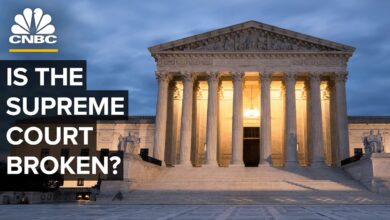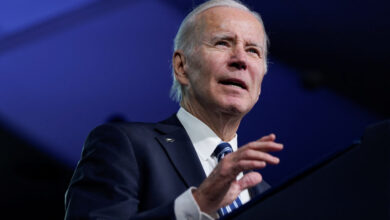How Do You Solve a Problem Like Joe Biden?
How do you solve a problem like Joe Biden? That’s the question swirling through the minds of many Americans, and frankly, it’s a complex one. This isn’t about simple partisan bickering; it’s about dissecting the realities of his presidency – the policy decisions, their impact, and the public’s often-divided perception. We’ll delve into his strengths and weaknesses as a leader, explore the challenges he’s faced, and consider his place in the broader context of American history.
Get ready for a thoughtful, in-depth look at the Biden presidency.
We’ll examine his economic policies, their effect on the average American, and how they compare to previous administrations. We’ll analyze his foreign policy decisions and their global ramifications, from the withdrawal from Afghanistan to his stance on the war in Ukraine. Beyond policy, we’ll explore the media’s portrayal of Biden, the role of social media in shaping public opinion, and the impact of key events on his approval ratings.
Ultimately, we aim to provide a balanced and nuanced understanding of this pivotal period in American history.
Biden’s Policy Decisions and Their Impacts
President Biden’s policy decisions have significantly shaped the domestic and international landscape since his inauguration. Analyzing these policies and their consequences requires a nuanced understanding of their economic, foreign policy, and environmental implications. The following sections delve into specific areas, offering a critical examination of their impact.
Economic Consequences of Biden’s Fiscal Policies
Biden’s fiscal policies, including the American Rescue Plan and the Bipartisan Infrastructure Law, have aimed to stimulate economic growth and address social inequalities. The American Rescue Plan, a large stimulus package, provided substantial funding for COVID-19 relief, unemployment benefits, and state and local governments. While this injection of capital helped bolster the economy in the short term, concerns remain regarding its contribution to inflation.
The Bipartisan Infrastructure Law, focused on upgrading roads, bridges, and other infrastructure, represents a long-term investment with the potential to create jobs and improve productivity. However, the long-term economic effects of both initiatives are still unfolding and subject to ongoing debate among economists. Some argue that the increased government spending has exacerbated inflationary pressures, while others maintain that the investments are crucial for future economic growth and competitiveness.
The ultimate success of these policies will depend on factors such as the effectiveness of implementation and the broader global economic climate.
Effects of Biden’s Foreign Policy Decisions on International Relations
Biden’s foreign policy has emphasized a return to multilateralism and a renewed focus on alliances after the Trump administration’s more isolationist approach. His administration rejoined the Paris Agreement on climate change and the World Health Organization, signaling a commitment to international cooperation. The withdrawal of troops from Afghanistan, while controversial, reflected a shift away from prolonged military interventions.
Biden’s approach to China has been characterized by a combination of competition and cooperation, seeking to address concerns about trade imbalances and human rights while also engaging in areas of mutual interest. His administration has also strengthened relationships with key allies in Europe and Asia, particularly in response to Russia’s invasion of Ukraine. The impact of these decisions is multifaceted, with some arguing that the renewed emphasis on multilateralism strengthens global stability, while others express concern about the potential for strategic vulnerabilities or unintended consequences in specific regions.
Comparison of Biden’s Environmental Policies to Previous Administrations
Biden’s environmental policies represent a significant departure from the approach of the previous administration. The Trump administration rolled back numerous environmental regulations, while Biden has sought to reverse these actions and implement more ambitious climate goals. For example, Biden rejoined the Paris Agreement and set a target of achieving a 50-52% reduction in greenhouse gas emissions by 2030.
This goal is significantly more ambitious than those set by previous administrations, requiring substantial investments in renewable energy and energy efficiency. The key difference lies in the prioritization of climate action as a central element of domestic and foreign policy. While the long-term success of these policies will depend on technological advancements, political will, and international cooperation, they signal a clear commitment to addressing climate change.
Timeline of Significant Policy Decisions and Outcomes
The following timeline highlights some of the most significant policy decisions made during Biden’s presidency and their subsequent outcomes:
- January 20, 2021: Inauguration of President Biden. Outcome: Marked a shift in political direction from the previous administration.
- March 11, 2021: American Rescue Plan signed into law. Outcome: Provided significant COVID-19 relief but also contributed to inflationary pressures.
- November 15, 2021: Biden rejoined the Paris Agreement. Outcome: Demonstrated a commitment to international climate cooperation.
- August 30, 2021: Withdrawal of US troops from Afghanistan completed. Outcome: Ended a long-running military intervention but led to criticism regarding the execution and its impact on Afghan civilians.
- November 2021: Bipartisan Infrastructure Law signed into law. Outcome: A significant investment in infrastructure, expected to have long-term economic and societal benefits.
Public Perception and Media Coverage of Biden
President Biden’s public image has been a dynamic and often contested landscape throughout his presidency. His approval ratings have fluctuated significantly, influenced by a complex interplay of policy decisions, media portrayals, and major events. Understanding this public perception requires examining both the positive and negative narratives that have shaped public opinion.Positive and Negative Media Portrayals and Their Impact on Public OpinionPositive media portrayals often highlight Biden’s experience, his perceived empathy, and his focus on issues such as infrastructure and climate change.
So, how do you solve a problem like Joe Biden? It’s a complex question, and honestly, understanding the bigger picture is crucial. That’s why I found the analysis in this article, analysis buffet 25 urgent things you need to know about spygate epstein china financial collapse mass shootings and civil war , so insightful. It helps contextualize current events and maybe, just maybe, sheds light on how to navigate these turbulent times and address the challenges posed by leadership.
Ultimately, solving “the Biden problem” requires a broad understanding of the interwoven crises facing our nation.
For instance, news coverage of the Bipartisan Infrastructure Law frequently emphasized its potential to create jobs and modernize the nation’s infrastructure, generating positive public sentiment among certain demographics. Conversely, negative portrayals often focus on criticisms of his administration’s handling of the Afghanistan withdrawal, rising inflation, or concerns about his age and cognitive abilities. These narratives, amplified by certain media outlets, can contribute to negative public opinion and fuel political polarization.
The impact of these contrasting narratives is evident in the fluctuating approval ratings that have characterized his presidency. For example, a surge in approval might follow a successful legislative achievement, while a significant drop could follow a major foreign policy setback.
The Role of Social Media in Shaping Public Perception
Social media platforms have played a significant role in shaping public perception of Biden’s presidency. The rapid dissemination of information, often unverified, through these platforms has created an environment where both positive and negative narratives can spread quickly and widely. Pro-Biden accounts often share positive news stories and highlight policy achievements, while opposing accounts focus on criticisms and negative news coverage.
The algorithmic nature of these platforms can further amplify these narratives, creating echo chambers where users are primarily exposed to information that confirms their pre-existing beliefs. This can lead to increased polarization and a fragmented public understanding of the president’s performance. The spread of misinformation and disinformation on social media also poses a significant challenge to accurate public perception.
The rapid spread of false or misleading information can significantly impact public opinion, even if later debunked.
Different Perspectives on Biden’s Leadership Style and its Effectiveness
Biden’s leadership style is often described as pragmatic and collaborative. Supporters praise his willingness to work with members of both parties, citing the Bipartisan Infrastructure Law as an example of his ability to achieve bipartisan consensus. Critics, however, argue that his approach can be too cautious and that it can lead to compromises that fail to fully address pressing issues.
So, how do you solve a problem like Joe Biden? It’s a question many are asking, and honestly, I don’t have all the answers. But seeing news like the impending layoffs at Twitter – check out this article: elon musk to begin twitter layoffs friday morning reports – makes me wonder if swift, decisive action is always the best solution.
Maybe the Biden “problem” needs a more nuanced approach than a mass firing.
Some perceive his attempts at bipartisanship as weakness, while others view it as a strength, crucial in a deeply divided political climate. The effectiveness of his leadership style remains a subject of ongoing debate, with varying perspectives shaped by individual political leanings and interpretations of his policy achievements and failures. His ability to unite a fractured nation is a key aspect of this ongoing discussion, with differing opinions depending on the observer’s political affiliation and their assessment of the current political climate.
Specific Events Influencing Public Opinion of Biden
Several specific events have significantly influenced public opinion of Biden’s presidency. The withdrawal of US troops from Afghanistan in 2021, for example, led to a sharp decline in his approval ratings, with many criticizing the chaotic nature of the withdrawal and its consequences. Conversely, the passage of the American Rescue Plan, designed to address the economic fallout from the COVID-19 pandemic, initially boosted his approval ratings, although its long-term impact on public opinion remains to be seen.
Economic indicators, such as inflation rates and unemployment figures, also play a crucial role in shaping public perception. Periods of high inflation, for instance, can negatively impact a president’s approval ratings, regardless of other policy achievements. These events demonstrate the complex relationship between specific policy decisions, their real-world consequences, and their impact on the president’s public image.
Biden’s Strengths and Weaknesses as a Leader
Assessing President Biden’s leadership requires a nuanced approach, acknowledging both his considerable achievements and areas needing improvement. His presidency has been marked by significant policy decisions, navigating a complex domestic and international landscape. Examining his strengths and weaknesses provides a clearer understanding of his impact and legacy.
Biden’s Leadership Strengths
President Biden possesses several key strengths that have shaped his leadership. These strengths, while not without their limitations, have contributed to his success in certain areas.
First, his extensive experience in government provides a deep understanding of the political process and the intricacies of policy-making. His decades-long career in the Senate and as Vice President under Obama have equipped him with a unique perspective and a vast network of contacts. This experience is evident in his ability to navigate complex legislative hurdles and build consensus, as seen in the passage of the Infrastructure Investment and Jobs Act.
Second, Biden’s emphasis on bipartisanship, while often criticized for its limitations, reflects a commitment to finding common ground and working with both Democrats and Republicans. This approach, while not always successful, demonstrates a willingness to compromise and seek solutions that benefit the broader population. The Infrastructure Investment and Jobs Act, which received bipartisan support, stands as an example of this approach.
Third, Biden’s empathetic and relatable communication style has resonated with many voters. He often presents himself as a pragmatic and down-to-earth leader, fostering a sense of connection with ordinary Americans. This approach has been particularly effective in moments of national crisis or tragedy, allowing him to offer comfort and reassurance.
Biden’s Leadership Weaknesses, How do you solve a problem like joe biden
Despite his strengths, President Biden faces several challenges in his leadership. Acknowledging these weaknesses is crucial for a complete assessment of his presidency.
One significant weakness is his perceived lack of decisiveness and a tendency towards incrementalism. Critics argue that his administration has been slow to respond to certain crises, and that his policy decisions have been too cautious or hesitant. The withdrawal from Afghanistan, for instance, has been cited as an example of this weakness, with criticism focusing on the execution and its aftermath.
Another weakness lies in his administration’s struggle to effectively communicate its policy goals and achievements to the public. While Biden aims for a relatable style, critics argue that this sometimes obscures the complexity of policy decisions, leading to misunderstandings and public dissatisfaction. The messaging surrounding the Build Back Better agenda, for example, faced significant criticism for its lack of clarity and effectiveness.
Finally, Biden’s age and health have become subjects of public discussion and concern. While he remains active and engaged, his age inevitably raises questions about his stamina and ability to effectively lead during a demanding presidency. This is a factor that impacts perceptions of his leadership and future prospects.
Comparison of Biden’s Leadership Style to Other Recent Presidents
Comparing Biden’s leadership style to that of his recent predecessors reveals both similarities and differences. Like Obama, Biden emphasizes diplomacy and international cooperation. However, unlike Obama’s more charismatic and inspirational style, Biden’s approach is more pragmatic and less overtly idealistic. Compared to Trump, Biden represents a stark contrast in terms of communication style and governing philosophy, favoring collaboration over confrontation.
So, how do you solve a problem like Joe Biden? It’s a complex question, and frankly, I’m not sure there’s a simple answer. Geopolitical factors play a huge role, and considering the rise of global powers, it’s worth asking if we’re seeing a shift in the world order, as explored in this fascinating article: is this a new age of warrior japan.
Understanding these shifts is crucial to navigating the challenges presented by figures like Biden, and finding solutions that address the underlying issues.
While Bush Jr.’s leadership was largely defined by the War on Terror, Biden’s presidency has focused on a more domestic agenda alongside international challenges.
Comparison of Biden’s Strengths and Weaknesses Across Different Areas
| Area | Strengths | Weaknesses | Overall Assessment |
|---|---|---|---|
| Domestic Policy | Experience, ability to build consensus (Infrastructure Bill), focus on social programs | Slow decision-making, communication challenges, legislative gridlock | Mixed results; some successes but significant challenges remain. |
| Foreign Policy | Emphasis on alliances, experience in international affairs | Challenges in Afghanistan withdrawal, navigating complex geopolitical landscape | A mixed record, marked by both successes and significant setbacks. |
| Communication | Empathetic and relatable style | Lack of clarity on complex issues, challenges in messaging policy achievements | Effective in some contexts, but needs improvement in conveying policy details and successes. |
Challenges Faced by the Biden Administration
The Biden administration inherited a nation grappling with unprecedented challenges, ranging from a global pandemic to deep political divisions. Navigating these complexities required immediate action and long-term strategic planning, often met with significant obstacles. This section examines some of the most significant hurdles faced by the administration during its early years.
COVID-19 Pandemic Response
The COVID-19 pandemic continued to pose a significant challenge throughout Biden’s first term. While the vaccine rollout was a major accomplishment, variant surges, vaccine hesitancy, and the ongoing struggle to contain the virus created persistent health and economic problems. The administration faced criticism regarding the speed and efficacy of its initial response, particularly concerning the distribution of vaccines and personal protective equipment (PPE).
Furthermore, the long-term economic consequences of the pandemic, including supply chain disruptions and labor shortages, required sustained and evolving policy responses. The administration’s efforts to mitigate the economic impact included the American Rescue Plan, a large stimulus package aimed at providing relief to individuals and businesses. However, the long-term effects of the pandemic and the effectiveness of these economic interventions remain subjects of ongoing debate and analysis.
Political Polarization and Congressional Gridlock
The deep political polarization that characterized the previous administration continued to hamper the Biden administration’s legislative agenda. The narrow Democratic majority in Congress frequently led to gridlock, making it difficult to pass even modest legislative proposals. This division was evident in debates over voting rights, infrastructure spending, and climate change legislation. The filibuster in the Senate proved a particularly significant obstacle, preventing the passage of several key Democratic priorities.
The administration’s attempts to bridge the partisan divide were often unsuccessful, highlighting the difficulties of governing in an era of extreme political polarization.
Major Domestic Policy Challenges
The Biden administration confronted a multitude of significant domestic policy challenges. These included addressing economic inequality, improving healthcare access and affordability, combating climate change, and reforming the immigration system. Economic inequality was a persistent concern, exacerbated by the pandemic and existing structural issues. Healthcare remained a contentious issue, with debates surrounding the Affordable Care Act and the need for broader healthcare reform.
Climate change posed a significant long-term threat, requiring substantial investments in renewable energy and infrastructure. Immigration reform proved particularly challenging, with disagreements over border security, asylum policies, and pathways to citizenship. These interconnected challenges required comprehensive and often politically complex solutions.
Hypothetical Scenario: Addressing Climate Change
Let’s imagine a scenario where the Biden administration prioritizes a comprehensive approach to climate change. This would involve a multi-pronged strategy. First, the administration would aggressively pursue investments in renewable energy sources, incentivizing the transition through tax credits and subsidies, while simultaneously phasing out fossil fuel subsidies. Second, a significant investment in upgrading the nation’s infrastructure, focusing on energy efficiency and resilience to extreme weather events, would be undertaken.
This might involve creating a robust national grid capable of integrating renewable energy sources and upgrading transportation systems to prioritize electric vehicles. Third, the administration would work with international partners to strengthen global climate agreements and promote international cooperation in addressing climate change. The potential outcomes of such a strategy could include a significant reduction in greenhouse gas emissions, the creation of new jobs in the renewable energy sector, and increased national security through energy independence.
However, challenges would remain, including the need to overcome political opposition and ensure a just transition for workers in the fossil fuel industry. This would require substantial investment in retraining programs and economic diversification initiatives in affected communities.
Biden’s Legacy and Historical Context: How Do You Solve A Problem Like Joe Biden
Assessing Joe Biden’s presidency requires situating it within the broader tapestry of American political history. His tenure, marked by significant challenges and policy initiatives, offers a unique case study for understanding the evolving dynamics of American leadership in the 21st century. Comparing his actions and their impact to previous administrations reveals both continuity and significant departures from established norms.Biden’s election in 2020 occurred against a backdrop of deep political polarization and national division.
The aftermath of the Trump presidency, marked by unprecedented challenges to democratic institutions and a surge in social and political unrest, profoundly shaped the context of Biden’s victory. His campaign centered on a promise of restoring normalcy and unity, a stark contrast to the preceding administration’s disruptive style.
Biden’s Political Career and Shaping Events
Biden’s long and impactful political career provides crucial context for understanding his presidency. His early career in the Senate, beginning in 1973, saw him involved in significant legislative battles, including the fight for civil rights and the passage of landmark crime bills. His time as Vice President under Barack Obama further shaped his policy perspectives and leadership style.
The passage of the Affordable Care Act, the response to the 2008 financial crisis, and foreign policy initiatives during the Obama years all left their mark on Biden’s political worldview. His role in shaping the Obama administration’s response to the Great Recession, for example, provided him with invaluable experience in managing economic crises, a skill he would later draw upon during the COVID-19 pandemic.
His involvement in foreign policy, particularly in the context of the Iraq War, also significantly influenced his approach to international relations as President.
Comparing Biden’s Presidency to Others
Biden’s presidency shares some similarities with those of other Democratic presidents who faced significant challenges. Like Franklin D. Roosevelt during the Great Depression, Biden inherited a nation grappling with a major economic crisis (the COVID-19 pandemic and its economic fallout). Similar to Lyndon B. Johnson’s ambitious Great Society programs, Biden’s agenda includes significant investments in social programs and infrastructure.
However, unlike Johnson’s near-unanimous support in Congress, Biden faced a deeply divided legislature, making the passage of his legislative agenda considerably more difficult. Compared to the relatively stable political climate during the Clinton years, Biden’s presidency has been characterized by far greater political polarization and partisan gridlock. The differences in the political and social climates of each era make direct comparisons complex but highlight the unique challenges Biden faced.
Biden’s Key Policy Initiatives and Historical Trends
A visual representation comparing Biden’s key policy initiatives to broader historical trends in American politics might look like this: Imagine a graph with a timeline spanning several decades. On the vertical axis, we could measure the level of government spending on social programs (e.g., healthcare, education, infrastructure). We could plot the spending levels of various presidencies, highlighting periods of expansion (like the New Deal and the Great Society) and periods of contraction (e.g., the Reagan era).
Biden’s spending initiatives, particularly the American Rescue Plan and the Bipartisan Infrastructure Law, would be plotted on this graph, showing their relative size compared to previous periods of government expansion. Another line could represent the level of political polarization, measured by factors such as the partisan composition of Congress and the intensity of political rhetoric. This would show how Biden’s presidency unfolded within a context of exceptionally high political polarization.
A third line could represent the level of economic inequality. This would illustrate how Biden’s policies aimed to address economic inequality, comparing them to past efforts and their successes or failures. This visual representation would illustrate how Biden’s actions fit within the larger historical context of American political and economic trends.
So, how
-do* you solve a problem like Joe Biden? The answer, as we’ve explored, isn’t straightforward. It’s a multifaceted issue involving economic realities, international relations, public perception, and the inherent challenges of leadership in a deeply polarized nation. While there’s no single solution, understanding the complexities of his presidency – his successes, his failures, and the historical context surrounding his time in office – is crucial for informed civic engagement.
Ultimately, the “solution” lies in continued dialogue, critical analysis, and a commitment to understanding diverse perspectives.





